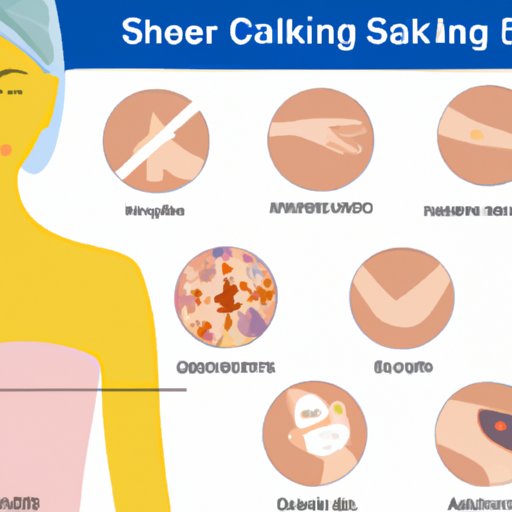
Introduction
Skin cancer refers to the abnormal growth of cells in the skin that can quickly spread and become dangerous. Early detection is key to successful treatment, making it important to understand the signs and symptoms of this disease. In this article, we will explore how to identify skin cancer, the importance of self-examination, risk factors, types of skin cancer, common misconceptions, when to see a doctor, and prevention tips.
Symptoms of Skin Cancer
The most common sign of skin cancer is a change in the appearance of moles or skin growths. Other symptoms include the development of new growths, bleeding or tingling of the skin, and unusual areas of skin. If you notice any of these symptoms, you should schedule an appointment with your doctor as soon as possible.
Self-Examination
Self-examination is an essential part of early detection. It is recommended that you examine your skin monthly and follow specific guidelines to ensure thoroughness. When examining your skin, be sure to look for changes in moles, new growths, and unusual areas of skin. If you notice any changes or have any concerns, schedule an appointment with your doctor immediately.
Risk Factors
There are several risk factors associated with skin cancer. Exposure to UV radiation from the sun and tanning beds is the most common. Individuals with a family history of skin cancer are also at an increased risk for developing the disease.
Types of Skin Cancer
There are three main types of skin cancer: basal cell carcinoma, squamous cell carcinoma, and melanoma. Basal cell carcinoma is the most common and least dangerous form of skin cancer. Squamous cell carcinoma is the second most common and more dangerous than basal cell carcinoma. Melanoma is the least common but the most dangerous form of skin cancer.
Common Misconceptions
Contrary to popular belief, individuals with darker skin tones can still develop skin cancer. Additionally, proper protection from the sun, such as seeking shade and wearing sunscreen, is essential for everyone regardless of skin color.
When to See a Doctor
If you notice any changes in your skin, such as new growths, changes in moles, or unusual skin areas, you should schedule an appointment with your doctor as soon as possible. Early detection can be crucial to successful treatment and recovery.
Prevention Tips
To prevent skin cancer, follow these tips: seek shade, apply sunscreen with at least SPF 30, and wear sun-protective clothing when spending time outdoors. Additionally, avoid tanning beds and limit your time in the sun, especially during peak hours.
Conclusion
In conclusion, early detection is key to successful skin cancer treatment and recovery. By being aware of the symptoms, self-examining your skin, and taking preventative measures, you can prioritize your skin health and reduce your risk of developing skin cancer. Remember to schedule regular appointments with your doctor and encourage others to prioritize their skin health as well.





